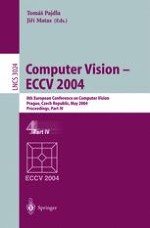Welcome to the proceedings of the 8th European Conference on Computer - sion! Following a very successful ECCV 2002, the response to our call for papers was almost equally strong – 555 papers were submitted. We accepted 41 papers for oral and 149 papers for poster presentation. Several innovations were introduced into the review process. First, the n- ber of program committee members was increased to reduce their review load. We managed to assign to program committee members no more than 12 papers. Second, we adopted a paper ranking system. Program committee members were asked to rank all the papers assigned to them, even those that were reviewed by additional reviewers. Third, we allowed authors to respond to the reviews consolidated in a discussion involving the area chair and the reviewers. Fourth, thereports,thereviews,andtheresponsesweremadeavailabletotheauthorsas well as to the program committee members. Our aim was to provide the authors with maximal feedback and to let the program committee members know how authors reacted to their reviews and how their reviews were or were not re?ected in the ?nal decision. Finally, we reduced the length of reviewed papers from 15 to 12 pages. ThepreparationofECCV2004wentsmoothlythankstothee?ortsofthe- ganizing committee, the area chairs, the program committee, and the reviewers. We are indebted to Anders Heyden, Mads Nielsen, and Henrik J. Nielsen for passing on ECCV traditions and to Dominique Asselineau from ENST/TSI who kindly provided his GestRFIA conference software. We thank Jan-Olof Eklundh and Andrew Zisserman for encouraging us to organize ECCV 2004 in Prague.
